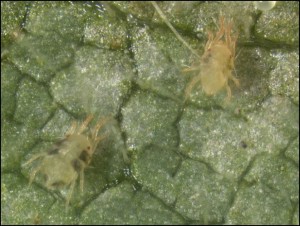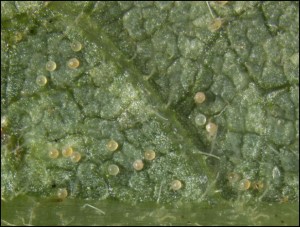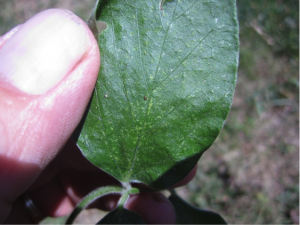Bryan Jensen, UW-Madison Dept. of Entomology and Integrated Pest Management Program
If this hot/dry weather has you thinking about two-Spotted Spider Mites (TSSM), we are on the same page. This prolonged weather pattern is certainly beneficial to increasing mite populations and I would recommend devoting some time to spot-checking corn and soybean fields.
As the name implies, this pest is a mite and not an insect. Adults are minute (< .02 inch), yellow green, have eight legs, and feeding stages have dark pigmented spots on either side of their oval bodies. Immatures are smaller than the adults and have either six or eight legs. Eggs are round and also yellow green.


Spot check fields or field areas you would consider droughty. Sandy soil, sandy knolls, south facing slopes and field edges are all good starting points. Mites are hard to see. A good handlense and a white sheet of paper can help with scouting. Tap leaves over the sheet of paper to dislodge mites and examine the paper with a handlense for their presence.
TSSM damage plants by piercing cells with their mouthparts and sucking sap. Because of their size, damaging populations often go unnoticed until significant yield loss has occurred. Recognizing early damage symptoms is very important. Early symptoms are often called stippling and can be described as flecking on the leaves. As populations increase, chlorosis, bronzing and ultimately necrosis can occur.


In soybean, treatment is recommended between crop stages R1-R5 if 15% or more of the leaf area is discolored and/or if stippled and live mites are present. For corn, control is suggested if one quarter to one-third of the foliage is injured and has live mite colonies are present. Economic injury is not expected after dent.
For control options please consult A3646 Pest Management in Wisconsin Field Crops.
In addition to the above treatment guidelines I will off the follow suggestions for your consideration:
- Read the pesticide label thoroughly. Understand there can be a big difference between suppression and control. A product that only claims mite suppression is unlikely to provide the control you need under moderate to high populations.
- Be vigilant with scouting. Control is best when treatments are applied on time. You do not want to play “catch-up” with high mite populations.
- Inspect soybean fields for presence/absence of soybean aphids. Their presence may (should) influence your recommendation. If aphids are increasing, choose a product with both mite and aphid efficacy.
- Do not underestimate the value of beneficial insects and mites in controlling TSSM and soybean aphids. Many of the suggested treatments are harmful to these beneficials. Spraying too early may lead to higher mite populations and/or soybean aphid flareups.
- Insecticides do not kill eggs. Miticides (Zeal, Oberon) may have some egg activity. Recheck mite populations after the REI has elapsed. Some REI’s are long.
- PHI: know the use of the crop before considering an application in corn. PHI’s are different for each use and late applications may interfere with timing of silage harvest.
- Mite resistance is a real issue. Alternate modes of action if a second application is needed. Some labels require it.
- Watch and do not exceed seasonal use rates for each active ingredient. Remember some products are combination of active ingredients and one or both may have been used previously for other insects.
- TSSM control is difficult and mites must come in contact with the pesticide. Efficacy is usually better with higher GPAs.
- Pesticides registered for corn may not be registered for soybean.
- Check the entire canopy for mites.
- Webbing is a sign that high populations of mites are/were present. Verify mite presence if you see webbing.
- Heavy rains can reduce populations. However, do not assume heavy rains will reduce or control TSSM
- Look at future weather reports. Consider delaying treatment if cool/wet weather is likely.
Take your mite management decisions seriously. Casual decisions are costly and can flare populations.
By the way, I understand if this weather had you thinking about patios, camping, ball games and great sunsets.